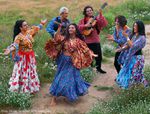Black Travellers
 A group of festive Black Travellers at one of their traditional festivals | |
| Total population | |
|---|---|
| 4,802,160 | |
| Regions with significant populations | |
| Distributed mostly evenly throughout Krasnarus, with a slightly larger concentration in Balkanshahr | |
| 3,529,120 | |
| 253,900 | |
| 1,019,140 | |
| 32,000 | |
| Languages | |
| Cascarot, Šlovedk | |
| Religion | |
| Mix of Nazarene and Umraist, as well as folk religion. | |
Black Travellers are a nomadic ethnic group very similar to the Romani peoples of the Balkans, who are evenly distributed through Krasnarus for the most part. Black Travellers are widely hated throughout the country by all ethnic groups, and are often shunned by society.
History
The origins of the Black Travellers are unknown, and they are genetically unrelated to the peoples around them. They arrived in the area that is now Krasnarus several hundred years ago.
Foreign interest
Since the year 1653 Ab Nortone (October 2017) Shirerithian recruitment agents have been observed operating in international waters sending landing parties ashore to recruit young female Black Travellers for ill-defined waitress vacancies in Shirekeep. Although so far the recruitment campaign has not been widely felt in the region, Shirerithian legitimate businessmen have been working industriously in seeking to make contact with promising young gupneks who might serve as talent scouts and recruiters on the ground in Krasnarus and the Florian Serb lands.
Of those who have made the journey westwards so far, it would appear that many - far from becoming serving staff in bars and restaurants - have instead become bathhouse attendants, a very disreputable profession in the Imperial Republic. It is estimated that about 20,000 Black Traveller women had been trafficked by the gupnek gangs to Shirekeep, which was the result of a series of backdoor deals on the latter. The implications of this, which place high-ranking officials in unsavory positions, have stirred controversy among the Parliamentarians of Krasnarus.
In 1659 the remaining Black Traveller population was sold to the ESB Group of Shireroth at the asking price of 1,589 Erb ($25) per head. Because Benacia had already enjoyed a decade long glut in cheap labour, the Black Travellers - excepting the 30,000 strong corps of bathhouse attendants already established - were to be resettled in Constancian territory to work on ESB projects overseen by its Euran Directorate.
The process of rounding up and herding together such a large population engendered a certain level of resistance, and it is expected to take several years to complete the relocation of the entire population.
Constancian relocation, assimilation and resettlement
A 1655 decree granted permanent residency to Black Travellers in Oranje for the duration of their service and employment, as well as exemption from Constancian taxation for any revenue earned. Under Constancian law, they do not possess further civil rights reserved to citizens, such as the right to vote or to be part of the Constancian government.
In 1662 the Raspur Pact began the devşirme recruitment campaign in the Constancian overseas territory of Oranje, initially recruiting a regiment of Black Travellers for the Home Guard assigned by the Free Associative Kingdom to the Apollonian Theatre Command under Shirerithian operational control.
In 1663, a decree registered them all into an Organization of Itinerant Eastern Apollonians, with a chief elected by them and serving for five years in office, as well as an Itinerant Eastern Apollonian Investigation Commission under the Constancian Government to ascertain the eligibility of any Black Traveller, for any who have petitioned to receive Constancian nationality in accordance with Constancian law, no later than 60 days after deprivation of residency due to termination of employment. The same decree created a settlement called Ypiretópolis (roughly translated as, "the city of those who serve"), along the coast some 10 kilometers east of Atacama, governed independently from the Oranje Theme by a Governor-General appointed by the Autokrator, and the location of two new schools, the Civil School and the Ypiretópolis Military Academy, for select Black Traveller orphans. This same pronouncement validated any lawful marriages contracted between Black Travellers and Constancian nationals prior to the promulgation of the decree, and granted the spouse and offspring Constancian nationality, subject to the review of the Itinerant Eastern Apollonian Investigation Commission sitting in Vey, and provided that no matrimony with any of the aforesaid foreign workers known as Wanderers or Travellers shall be performed without authority of the Autokrator.
Records concerning the Black Travellers were largely lost during the evacuation of Vey during the Second Euran War. Those that remained within Constancian territory after the reconsolidation around the Gulf of Aqabah were enslaved and reduced to kul status.
Census
As of 1653, out of 2,554,857 self-identified Black Travellers, 50.0% of them male and 50.0% female. 99.1%, or 2,532,987 individuals, were living in poverty, and their average income was Cr2,104. 16.16% had employment, and 0.2% of individuals over age 26 had college degrees - the lowest statistic of any ethnic group. 800,304 individuals of Black Traveller descent were on the Registry of Individuals Convicted of Felony Offenses (RFUUZTČ).
Areas with significant populations
Krasnarus
- Albion (1,982,330)
- Sylvania (396,078)
- Phedodah (112,392)